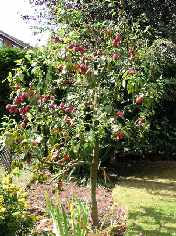Categories
Calendars
Guides
- Help on the Allotment
- Greenhouse World
- The Perfect Lawn
- Water Garden Features
- Beginner's Corner
- Pest and Disease
- Garden Techniques
Reviews
Archive
Gallery
Articles
Ask Our Gardening Expert
Plum Tree Care (continued - page 4)
Plum Tree Care
(continued - page 4)
Care of Plum Trees
With newly planted trees, check in their first winter that they are not lifted by frost, and provide them with
water during dry spells. Plum trees grown against a wall or fence will need more regular watering throughout their life.
 With
more mature trees, very little care other than pruning and thinning (see
later in this article) is required. Your plum tree will definitely thank you for a layer of
well-rotted compost spread around, but not touching, the trunk. Early spring
is the best time for this, to help preserve water and keep weeds at bay.
With
more mature trees, very little care other than pruning and thinning (see
later in this article) is required. Your plum tree will definitely thank you for a layer of
well-rotted compost spread around, but not touching, the trunk. Early spring
is the best time for this, to help preserve water and keep weeds at bay.
An Autumn application of a long lasting fertiliser such as bonemeal will keep them well fed and ready for growth next year.
Because plum trees have lots of roots near the surface, they will often produce lots of of suckers (mini-trees) for 3 metres (9 foot) around the trunk. Regular cutting of these suckers will keep them under control. A more permanent way is to gently dig away the soil to the point where the sucker joins the main root system. Simply pull the sucker away from the root. This will slow down the production of suckers considerably.
Thinning Plums
Plum trees can be a bit erratic in producing fruit - one year they
produce too little and the next year they produce too much. In years
when they produce too much, it's best to remove some fruit before it
matures to ensure a good crop next year and also better quality fruits
this year. The other danger of producing too much fruit is that the
branches may not be able to support their weight and they may break.
Thin the fruits at two stages in the year. First in late mid-May when the fruits are beginning to form, the again in July when the plums are about half their full size. First, remove any damaged or diseased fruit. Then, aim to thin the fruit so that there is enough room for the plums to develop without touching each other - about 7cm (3in) between each plum.
Supporting
Branches
If the weight on some of the branches looks like it may cause them to break, it will
be necessary to support the branch with a stake from below. Where this
is done, pad the branch with some sort of material at the point it is
supported by the stake. This will prevent the branch rubbing on the
stake and maybe letting disease in.

